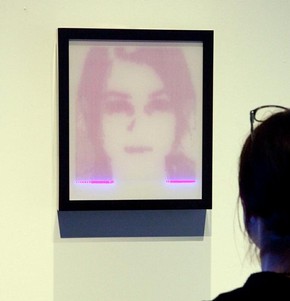Conservation Journal
Spring 2011 Issue 59
I’m always touched (by your presence dear)
Clair Battisson
Preservation Conservator

Figure 1 - 'Dandelion', Yoke & Sennep, 2009. A modified hairdryer is directed at the projected dandelion and the seeds are blown away. Photography by Peter Kelleher
Interactive art takes the audience into account by instigating multi-sensory collaborations between the two. As contemporary art is often considered difficult to understand, participation with an interactive work may break down barriers and possibly enhance a visitor’s experience of a museum environment.
The V&A exhibition Decode: Digital Design Sensations (8 Dec 2009 – 11 April 2010) presented the latest developments in digital and interactive design. The selected works ranged from screen based graphics to large scale installations. Objects were produced from a variety of media including: animation, responsive technologies, plastics, mirror and film (Figure 1 & 2).
Generally, audiences are so in tune with technology that familiarity and confidence can present problems when exhibiting interactive art in public spaces, such as the V&A. Customary museum boundaries become blurred when an object necessitates touch, movement or sound to function. While visitors are encouraged to explore the interactive interpretation found in many of the Museum’s galleries, it is understood that any corresponding objects must not be touched. Frames, cases, plinths and barriers provide protection and remind visitors of an object’s significance and value. Conversely, does it suggest an object has less value and is replaceable if it is displayed unprotected and requires touch to fully function?

Figure 2 - 'Study for a mirror', rAndom International, 2008. The collaborator stands in front of the frame for a few minutes, while an embedded scanner produces a temporary image. Photography by Peter Kelleher
Decode presented a steep, practical learning curve for the Conservation Department. The installation, exhibition and tour preparation provided the opportunity to produce and refine documentation and a working method specific for this type of object, which we will continue to develop and expand upon. Misjudging the level of interaction required for an outcome may result in wear and tear and occasionally damage, which must also be clearly recorded and where necessary repaired.
The exhibition also highlighted the importance of direct contact with artists and designers for this type of exhibition and any future interactive acquisitions. A material and working method an artist or designer considers resilient and fit for purpose may be deemed sensitive and unsuitable by the conservator; especially when presented in a public space and heavily reliant on touch. In some cases, the exhibition lifespan, and occasional mishandling,, impacted significantly on an object’s development. Decode was attended by 94,472 visitors, a situation which could not be recreated in a studio environment. The works were exposed to an extreme response, revealing outcomes which have helped the artists/designers with modifications for future generations of their works.
We still have work to do regarding our audience’s understanding of how to collaborate with interactive art; managing and meeting expectations is quite a difficult undertaking. Individual object invigilation may not be appropriate for some of works, or financially possible. Heavy control may remove some of the subtle, personal, unexpected experiences produced by the works and their collaborators. Further it may also portray the objects as technology, following a science fair or theme park manner of cooperation and team spirit. As previously with video art, perhaps this type of work needs to gain a certain distance and independence from its technology to fully establish itself as an art form with in a museum context. Decode: Digital Design Sensations is a collaboration between the V&A and onedotzero. https://www.vam.ac.uk/microsites/decode/

Spring 2011 Issue 59
- Editorial
- Keep Your Hair On - The development of conservation friendly wigs
- ‘X’ Marks the Spot: The conservation and correction of a Carlo Bugatti Chair
- Removing and re-attaching paper labels
- Will it stand? Morris and Co. wallpaper stand book
- Melting pot: Conserving wax objects in textile conservation
- The effects of fingerprints on silver
- The conservation of John Constable’s six foot sketches at the V&A
- The show must go on: Touring textile and costume objects with hazardous substances
- Dust to dust. Access to access.
- An update on lasers in sculpture conservation
- An approach to conserving study collections
- I’m always touched (by your presence dear)
- The contemporary art of documentation
- The Popart project
- V&A launches new National Conservation Diploma and the Conservator Development Programme
- Editorial board & Disclaimer
- Printer friendly version